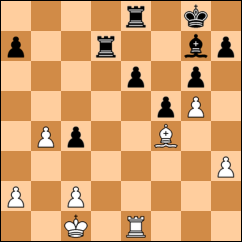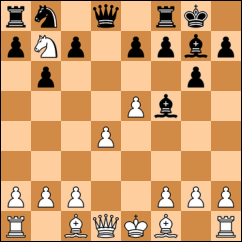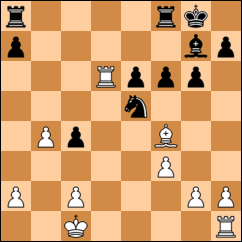K.Conter–K.Ammann
Route 20 Chess Club
Freeport, Ill., Nov. 16, 2010
1.d4 d5 2.Nf3 Nf6 3.Nc3
It's funny: I coach a team of middle school players, and one of them was confronted with exactly this unusual line at the Illinois Chess Association All-Grade Championship this past weekend. He replied by mirroring his opponent. I decided to take a different approach: turning it into a sort of Grünfeldy thing.
3...g6 4.e4 Bg7
Hewing a little too closely to my plan. I should have examined 4...dxe4!? before fianchettoing the bishop.
5.e5 Ne4 6.Ng5
There's also 6.Nxe4 dxe4 7.Ng5.
6...0-0
For some reason, I perseverate on the "threat" of Nxf7 (not really a threat yet, since without backup it throws away a knight for a pawn) and fail to notice that my knight is under attack. 6...Nxc3!? 7.bxc3 c5 is my best option.
7.Ngxe4 dxe4 8.Nxe4
Now I'm a pawn down. A cunning plan is required.
8...Bf5 9.Nc5
9.Ng3 forces the bishop back.
9...b6 10.Nb7??
This is a stroke of luck for me. My queen can easily sidestep the attack, after which the knight has nowhere to go.
10...Qd7 (10...Qd5 may be more direct) 11.Bf4 Be4 12.f3
The knight is toast. Ken may as well force me to double my pawns on the a-file on the way out: 12.Na5 bxa5 13.f3 Bb7. By itself, 12.f3 is a thank-you move, "forcing" me to do what I intend to do anyway.
12...Bxb7 13.Qd2 c5 14.0-0-0 Nc6
I'm eager to catch up on development, but I can win back my pawn with 14...Qa4 15.Kb1 Rd8 16.Bd3 cxd4.
15.dxc5 Qxd2 16.Rxd2 bxc5
This move isn't obviously bad unless you read a few more moves down the line: 17.e6 fxe6 18.Be3 and the c-pawn is vulnerable.
17.Bc4 Nxe5 18.Bd5 Bxd5 19.Rxd5 f6 20.b3
I guess this is to prevent ...Nc4, but the pawn pickup 20.Rxc5 is a freebie. Following up with 20...Rfc8 21.Rxc8+ Rxc8 22.Bxe5 fxe5 brings us quickly into the endgame. In this variation I'm up a piece for a pawn, but my doubled e-pawns look awful.
20...c4 21.b4 e6 22.Rd6
22...Rfe8
There's something to be said for 22...Rfb8!? -- "Here, go ahead, have my e-pawn." If the bait is taken, 23.Rxe6 Rxb4 24.Bd2 c3 25.Bxc3 Bh6+ 26.Bd2 Rab8 27.Bxh6 Rb1+ 28.Kd2 Rxh1 is decisive, winning the exchange.
23.g4 Nxf3 24.Rf1 Ne5
24...e5 is better. "Sure, take my knight. And I'll have your bishop, thanks." After 25.Rxf3 exf4, the pawn capture 26.Rxf4?? steps into a pin, 26...Bh6.
25.g5 f5 26.h3 Nf7 27.Re1 Nxd6
Obvious, right? But 27...e5 is even more brutal: if white doesn't move off with 28.Rd7, he loses the rook anyway, and if he does, he loses the bishop after 28...exf4.
28.Bxd6 Rad8 29.Bc7 Rd7 30.Bf4

30...e5
I should get the bishop out first: 30...Bc3!? 31.Rd1 e5 32.Bg3 (32.Rxd7 exf4 33.Rd3 cxd3) 32...Rxd1+ 33.Kxd1 Rd8+ 34.Ke2 Rd2+ 35.Kf3 Rxc2 and white has no hope left.
31.Bh2 c3 32.Re2 Rd2
This powerful-looking move is actually a setback. Better is 32...a5 33.b5 (33.bxa5 allows 33...Rb8 34.Rd2 Rxd2 35.Bf4 exf4 36.a4 [36.a6 Rb1+ 37.Kxb1 Rd1#; 36.a3 Bf8 37.h4 Bxa3#] Rh2 37.Kd1 [37.a4 Rh1#] 37...Rb1#) 33...Bf8 34.a4 Red8. You saw that, I'm sure.
33.Rxd2 cxd2+ 34.Kxd2 Rd8+ 35.Kc1
Is it wise to run back into the corner? Now I'm going to use my rook to keep Ken's king away from my advancing pawn.
35...f4 36.a4 f3 37.Bg1 Rf8
A player with a more wicked imagination might see 37...e4 38.Bxa7 Bd4!, forcing the exchange of bishops -- 39.Bxd4 Rxd4 -- and sacrificing the rook in favor of a brutal two-queen finale, 40.c3 f2 41.cxd4 f1Q+ 42.Kc2 Qd3+ 43.Kb2 e3 44.Ka2 e2 45.d5 e1Q 46.d6 Qeb1#.
38.b5 f2 39.Bxf2 Rxf2 40.a5 Rf4 41.b6 axb6 42.axb6 Rb4 43.c3 Rxb6 44.Kc2 Rd6 45.c4 e4 46.c5 Rd5 47.c6 Be5 48.Kb3 e3 49.Kb4 e2 50.Kc4 Rd1 51.Kc5 e1Q 52.c7 Bxc7 53.Kc6 Qc3+ 54.Kb7 Bh2
You're not hiding behind me!
55.Ka8 Rb1 56.Ka7 Qa3# 0-1






0 comments:
Post a Comment